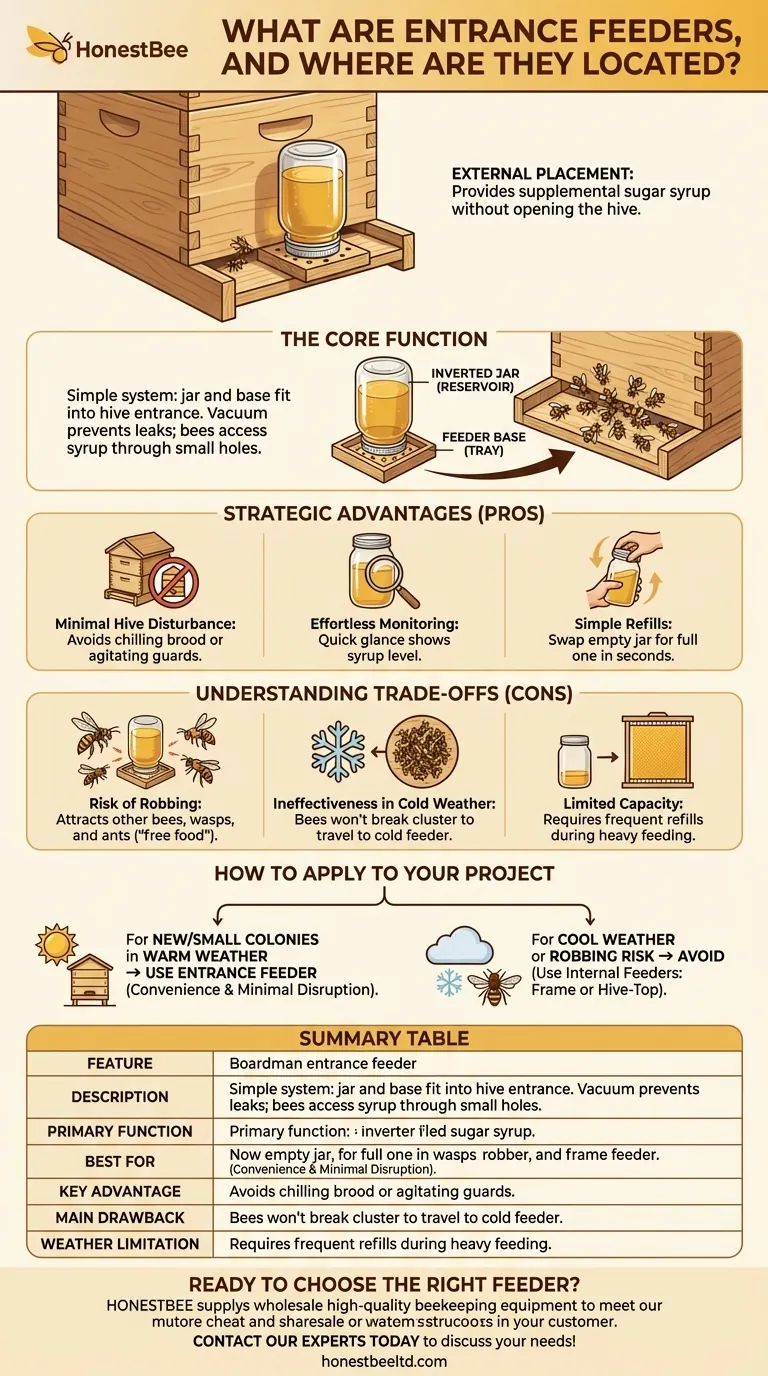An entrance feeder is a simple device placed directly at the main entrance of a beehive to provide bees with supplemental sugar syrup. Its defining feature is its external placement, which allows a beekeeper to monitor and refill the syrup supply without opening the hive and disturbing the colony.
While entrance feeders offer unparalleled convenience for quick monitoring and refilling, their external design makes them vulnerable to other insects and less effective in cold weather, defining their specific role in hive management.

The Core Function of an Entrance Feeder
An entrance feeder, also known as a Boardman feeder, is one of the most common and straightforward methods for feeding a honey bee colony.
How It Works
The feeder consists of a base that fits snugly into the hive entrance. A container, typically an inverted Mason jar filled with sugar syrup, is placed on this base. Small holes in the jar's lid allow the syrup to be accessed by the bees from inside the hive while a vacuum prevents it from leaking out.
Key Components
The system is remarkably simple. It has only two parts: the plastic or wooden base that serves as the feeding tray and the inverted container that acts as the reservoir for the syrup.
The Strategic Advantages
Beekeepers choose entrance feeders for several distinct benefits, all centered on ease of use and minimal disruption to the colony.
Minimal Hive Disturbance
The primary advantage is the ability to feed the bees without opening the hive. This avoids chilling the brood, agitating the guard bees, and disturbing the colony's internal environment.
Effortless Monitoring
Because the jar is on the outside of the hive, a beekeeper can see the syrup level with a quick glance. This makes it incredibly easy to know exactly when a refill is needed without any guesswork.
Simple Refills
Refilling is as simple as swapping the empty jar with a full one. This can be done in seconds, minimizing your time at the hive and further reducing stress on the colony.
Understanding the Trade-offs
Despite their convenience, entrance feeders have significant drawbacks that every beekeeper must consider. Their external placement is both their greatest strength and their most critical weakness.
The Risk of Robbing
Placing a food source at the hive's entrance is like putting up a sign that says "free food." It can easily attract bees from other colonies, as well as wasps and ants, initiating a "robbing" frenzy where the stronger colony attacks the weaker one to steal its resources.
Ineffectiveness in Cold Weather
Bees form a tight cluster to stay warm in cool or cold temperatures. They will not break this cluster to travel to the cold entrance of the hive to consume even colder syrup. This makes entrance feeders unsuitable for feeding in late fall, winter, or early spring.
Limited Capacity
Compared to internal hive-top or frame feeders, the standard Mason jar used for an entrance feeder holds a relatively small amount of syrup. During periods of heavy feeding, this can require daily refills.
How to Apply This to Your Project
Your choice of feeder should always be dictated by the season, the strength of your colony, and your specific management goal.
- If your primary focus is convenience for a new, small colony in warm weather: The entrance feeder is an excellent tool for providing supplemental support with minimal disruption.
- If your primary focus is preventing robbing or feeding in cool weather: You should use an internal option, such as a frame feeder or hive-top feeder, to protect the food source and keep it close to the bees.
Ultimately, understanding these distinct pros and cons allows you to use the entrance feeder as a highly effective tool at precisely the right time.
Summary Table:
| Feature | Description |
|---|---|
| Primary Function | Provides supplemental sugar syrup to bees from outside the hive. |
| Best For | Convenient feeding for new/small colonies in warm weather. |
| Key Advantage | Minimal hive disturbance; easy to monitor and refill. |
| Main Drawback | High risk of attracting robbers (other bees, wasps, ants). |
| Weather Limitation | Ineffective in cold weather as bees won't break their cluster. |
Ready to choose the right feeder for your apiary?
Whether you're managing a few hives or a large commercial operation, having the right equipment is key to success. HONESTBEE supplies durable, high-quality beekeeping supplies and equipment—including a full range of feeders—to commercial apiaries and beekeeping equipment distributors through our wholesale-focused operations.
Let us help you build a more efficient and productive beekeeping business. Contact our experts today to discuss your needs and explore our wholesale catalog!
Visual Guide

Related Products
- Professional Hive Front Entrance Bee Feeder
- HONESTBEE Entrance Bee Feeder Professional Hive Nutrition Solution for Beekeeping
- HONESTBEE Entrance Bee Feeder Efficient Hive Front Liquid Feeding Solution for Beekeeping
- Boardman Entrance Bee Feeder Durable Galvanized Steel and Wood Construction for Beekeeping
- HONESTBEE Professional Entrance Bee Feeder Hive Nutrition Solution
People Also Ask
- How does the entrance feeder method work? A Guide to Simple But Risky Hive Feeding
- What is an entrance feeder and how is it used? Avoid the Critical Risk of Robbing
- How is the mesh ladder and barrier installed in the feeder box? A Step-by-Step Guide to Prevent Bee Drowning
- How do you make an entrance feeder for bees? A Guide to Safe & Effective Hive Feeding
- How to make an entrance feeder for bees? A DIY Guide for Safe & Effective Feeding



















